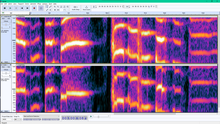Pitch correction
Pitch correction is an electronic
History
Prior to the invention of pitch correction, errors in vocal intonation in recordings could only be corrected by re-recording the entire song (in the early era of recording) or, after the development of
Pitch correction was relatively uncommon before 1997 when Antares Audio Technology's
Auto-Tune is still widely used, as are other pitch-correction algorithms including
Uses

Pitch correction
The most common use of pitch correctors is to fix wrong intonation (tuning) of notes sung by vocalists in popular music sound recordings. The use of pitch correction speeds up the recording process, because singers do not need to keep singing a song or vocal line and re-recording it until the pitches are correct. The pitch correction software can correct any pitch errors in the singing without the need for overdubbing or re-recording.
While pitch correction is most associated with fixing vocal intonation errors, it can also be used to fix intonation in recorded instrumental parts such as violin, cello or trumpet.
Vocal harmony and vibrato
Pitch correctors are commonly used in music studios to add the sound of
Extreme effects
While pitch correction devices were initially designed to produce natural-sounding effects, producers discovered that by setting extreme parameter values, unusual effects could be obtained. Pitch correction devices became popular in the late 1990s as a distinctively electronic,
Criticism
One criticism of pitch correction is that it allows recording engineers to create a perfectly in-tune performance from a vocalist who is otherwise not skilled enough to give one, adding a degree of dishonesty to music.[5] This concept was featured in a 2001 episode of The Simpsons, entitled "New Kids on the Blecch". In the episode, a cartoon representation of a pitch corrector (labeled "Studio Magic") was used to make up for the total lack of singing talent in a manufactured boy band, of which Bart Simpson was a member.
In 2003, Allison Moorer began attaching stickers to her 2002 album Miss Fortune reading "Absolutely no vocal tuning or pitch-correction was used in the making of this record."[6]
A Chicago Tribune report from 2003 stated that "many successful mainstream artists in most genres of music—perhaps a majority of artists—are using pitch correction".[7] Timothy Powell, a producer/engineer, stated in 2003 that he is "even starting to see vocal tuning devices show up in concert settings"; he states that "That's more of an ethical dilemma—people pay a premium dollar to see artists and artists want people to see them at their best."[7]
In 2010, producer
See also
- Audio time stretching and pitch scaling
- Puberphonia
- Pitch shift
- Phase vocoder
- Lip syncing in music
References
- ^ Editorial, Antares (28 January 2023). "Auto-Tune Inventor Dr. Andy Hildebrand Wins 2023 Technical GRAMMY!". Antares Tech. Retrieved 7 September 2023.
- ^ Anderton, Craig. "In Search of the Perfect Pitch; The fix is in". EQ. 2006-07-01. Pg. 46.
- ISBN 978-1-4411-5607-5.
- ^ Sillitoe, Sue & Bell, Matt (1999-02). "Recording Cher's Believe". Sound on Sound. Retrieved on 2008-04-14.
- ^ Daley, Dan (October 2003). "Vocal Fixes: Modern Vocal Processing In Practice". Sound on Sound. Retrieved 2009-02-12.
- ^ Everett-Green, Robert. (2006-10-14). "Ruled By Frankenmusic; The computer program that cleans up singers' pitch is reshaping the character of pop". The Globe and Mail (Canada). Pg. R1.
- ^ a b Ryan, Maureen (27 April 2003). "What, no pitch correction?" (PDF). Chicago Tribune. Archived from the original (PDF) on 15 June 2011. Retrieved 2010-04-25.
- ^ a b Collett-White, Mike (2010-12-13). "Voice on Jackson album far from finished article". Reuters (UK Edition). Thomson Reuters.
